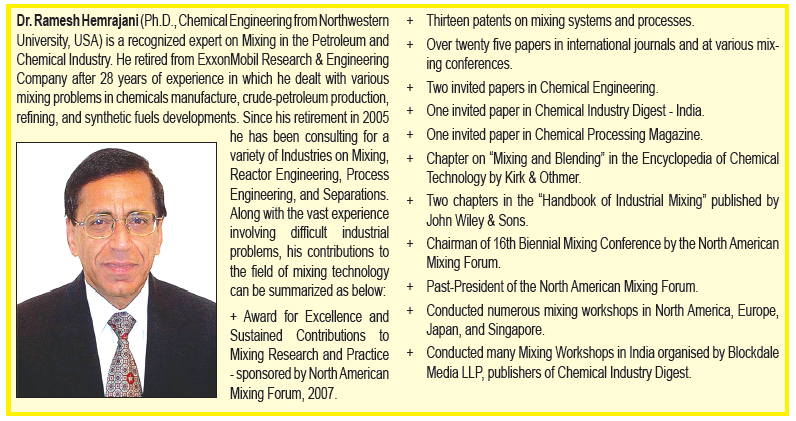Industrial Mixing is a crucially important operation, particularly for chemical reactions. Even a percentage increase in yields, due to good mixing, translates into millions of dollars earned in a year. For the very viability of manufacturing, good mixing is a major pre-requisite. Good mixing enhances productivity of wanted products while significantly reducing unwanted products, which also means not having to handle huge wastes.
Significant advances have taken place in mixing and therefore Chemical Industry Digest discussed various aspects of mixing with Dr Ramesh Hemrajani, a well recognized internationally known expert on mixing, in this interview presented here.
Excerpts from the interview:
Chemical Industry Digest (CID): Mixing, despite sounding simplistic, crucially important for reactions, is said to be the most complex to control as it is the least understood of many operations. Why is this so?
Dr Ramesh Hemrajani (RH): In the old days mixing was considered as “Shaken” but not “Stirred”. In order to mix two liquids, one would add them in a container which was then shaken by hand. As chemical processing evolved, just bringing liquids together without regard to quantification of homogeneity, led to poor process results. Emergence of processes using multiple phases necessitated understanding of mixing technologies for Single Phases, Solid-Liquid, Immiscible Liquids and Gas-Liquid systems.
When taking chemical reactions into account, mixing becomes more complex because the desired end results include reaction yield and selectivity; both leading to productivity and product quality. Depending on reaction kinetics and heat of reaction, sometimes ‘Runaway’ reactions can be triggered due to poor mixing.
We have come a long way to understand mixing requirements and developing recommendations on selection of mixer type and sizing it. As the chemical industry is demanding high productivity and better product quality, we continue to research on mechanisms of mixing with Rotating and Static mixing technologies.
 CID: What are the main criteria or the decisive or controlling parameters for good mixing? And what are all the benefits of good mixing?
CID: What are the main criteria or the decisive or controlling parameters for good mixing? And what are all the benefits of good mixing?
RH: The criteria for good mixing depend on phase configuration. For single phase liquid blending it is important to achieve liquid homogeneity at 95% or higher. The controlling parameter would be how long it takes to achieve that homogeneity. While in small mixing tanks it takes seconds or minutes for good blending, in large tanks it may take hours and days.
For suspension of solids in liquids, minimum requirement is complete off-bottom suspension. Higher mixing would provide distribution of solids to higher levels and even all the way to top. For immiscible liquid mixing, the mixing criterion is achieving desired mass transfer rate which is inversely proportional to the dispersed phase drop size.For gas-liquid mixing the criterion is similar and mass transfer rate determines the mixing quality.
There are a variety of benefits from good mixing – good product quality, faster reactions, higher yield and selectivity. It also minimizes cost of product separations by reducing by-products.
CID: What are the chief factors for mixing to go wrong or be inconsistent?
RH: Inadequately designed mixing systems could lead to poor mixing. Additional factors include incorrect sizing of wall baffles and selection of unsuitable mixer components. A well designed mixer should also be operated appropriately. For example; liquid level should be maintained within an acceptable range, and location of additive insertion should be away from regions of low turbulence.
CID: Is it important in each case to do lab scale/pilot trials to help in selecting the mixer type & for optimizing mixing?
RH: Once process requirements are well defined and they are within the existing knowledge base, laboratory and pilot studies may not be needed. Literature review may provide appropriate design guidelines. However, if the process is complex with non-Newtonian liquids and multiple reactions, laboratory/pilot studies are useful in defining mixing requirements. In some cases scale-up studies may also be needed to develop mixing system design recommendations.
CID: What are the major challenges faced in scale up and how can this be addressed?
RH: Scale-up is almost always challenging. Various flow characteristics such as Reynolds number, Froude number, Weber number etc. change as the mixer is scaled up. Sometimes it becomes important to determine which flow characteristics control mixing, and what impacts their different values on the process result. This step is defined as establishing the scale-up criteria.
A robust scale-up methodology may require experimentation at 2 to 3 different scales. The experimental results can then be used to correlate process result with changing combination of flow parameters.
CID: Where or at what stage does CFD come in and what are the benefits of using CFD to enable mixing efficiency?
RH: CFD is a valuable tool for understanding impact of mixing on process performance. However there are some limitations.
First, at this time confidence in CFD approach for single phase systems is high, but for multi-phase systems it is less reliable. Second, while CFD can provide detailed flow fields, additional computations are needed to further analyze the process. For example, transient calculations must be carried out to estimate blend time, and residence time distribution in continuous processes. Such calculations require longer computation time. For multi-phase systems, appropriate mathematical models must be used in addition to CFD calculations or experimental data must be obtained.
In case of processes carried out under high pressure and/or high temperature, CFD becomes cost effective as laboratory experimental units are costly to assemble and operate.
CID: There are many types of mixers. And there are many types of impellers and even their positioning as single or multiple impellers. Are there any thumb rules for selecting which mixer or mixers for which application? Where are inline & static mixers used? What are specialty mixers?
RH: Responding to this question requires extensive discussions. Perhaps by attending a Mixing Workshop one can obtain understanding of how to select various mixing technologies and design them. However I can provide a brief response as follows.
First, the use of in-line and static mixers are suitable for continuous processes where short mixing times (seconds to <1 minute) are acceptable. Second, rotating impeller mixing systems can be used for batch and continuous processes requiring longer residence times. Third, the selection of impeller type depends on fluid configuration. Different impellers have been generally identified for blending, solids suspension, immiscible liquids and gas-liquid mixing. It is important to use a right impeller that will provide highest mixing efficiency. Fourth, mixer details such as number of impellers and impeller spacing are set by some thumb rules available in the literature. Occasionally these rules need to be modified depending on available hardware.
CID: Do mixers have to be custom built specific to each process or can they be bought off the shelf?
RH: It is generally cheaper to buy impellers off the shelf. Vendors have developed different impellers specifically for process phase configurations. Besides using the established impellers, it allows the mixer users to have access to their performance characteristics such as power number and pumping number.
CID: From your long years in process industry and particularly with your expertise in mixing, which are some of the major problem areas in mixing when it comes to different kinds of mixing: liquid-liquid, gas-liquid, solid-liquid etc, etc, and in each type?
RH: Instead of stating as major problems, I would phrase it as major challenges. The most difficulty in all mixing areas is translating process requirements to mixing requirements. Once this step is done successfully, it becomes easy to design a mixing system.
For liquid blending, one must define degree of homogeneity and blend time requirements. For suspension of solids, the process needs range from off-bottom suspension to complete homogeneity. For immiscible liquids mixing, it is necessary to determine drop sizes and drop size distribution. Additionally engineers have to determine if there are any issues with settling emulsions. For gas-liquid mixing, it is important to quantify mass transfer rate and flow regime.
These process-to-mixing translations may require laboratory experimentation.
CID: Do micro-reactors that are showing great promise obviate the need for a separate mixing equipment?
RH: Micro-reactors are designed to provide mixing using fluid velocities through small channels. The use of rotating or static mixers would be difficult in these structures. In addition, due to their small dimensions the flow regimes tend to be laminar or at best transient. Mixing under these conditions can be slow.
CID: And finally last question is it necessary for a chemical company to have a mixing consultant on call to advise, from selection to operation? Would you as a leading mixing consultant like to continue to offer your consultancyfor Indian companies as you have done in the past?
RH: Having a “Expert” in the organization can bring a high value to the company. Mixing is a technology very commonly used in the process industry. An expert can advise on the selection and design of efficient mixing systems when a new chemical plant is planned. In addition, operating plants can develop mixing failures due to process changes.
Recommendations for mixer modifications need to be developed by an engineer with strong mixing background. In the absence of a resident expert, one must rely on mixing vendors who may not have good understanding of the process.
After my retirement I have been continuously busy with consulting on mixing for a variety of industries. It will be a pleasure to consult for Indian companies as my 43 years of experience in mixing can solve problems and enhance profitability.
Announcement
Announcement
Webinar on Industrial Mixing
Led by Dr Ramesh Hemrajani, Chemical Industry Digest would be shortly conducting a Webinar on Mixing which will sensitise participants to all aspects of the state-of-the art developments in mixing and thus help enable delegates to understand the potential of process efficiencies from good mixing.
Chemical Industry Digest has conducted many workshops & conferences on Industrial Mixing with Dr Ramesh Hemrajani as the faculty. The feedback after each event from the delegates was excellent.
The final details of the webinar are being worked out and the entire agenda, date, timings, schedule etc will be informed, once finalised.
Should you be interested to know more on this webinar, please register here: https://bit.ly/3Gqw9tY































